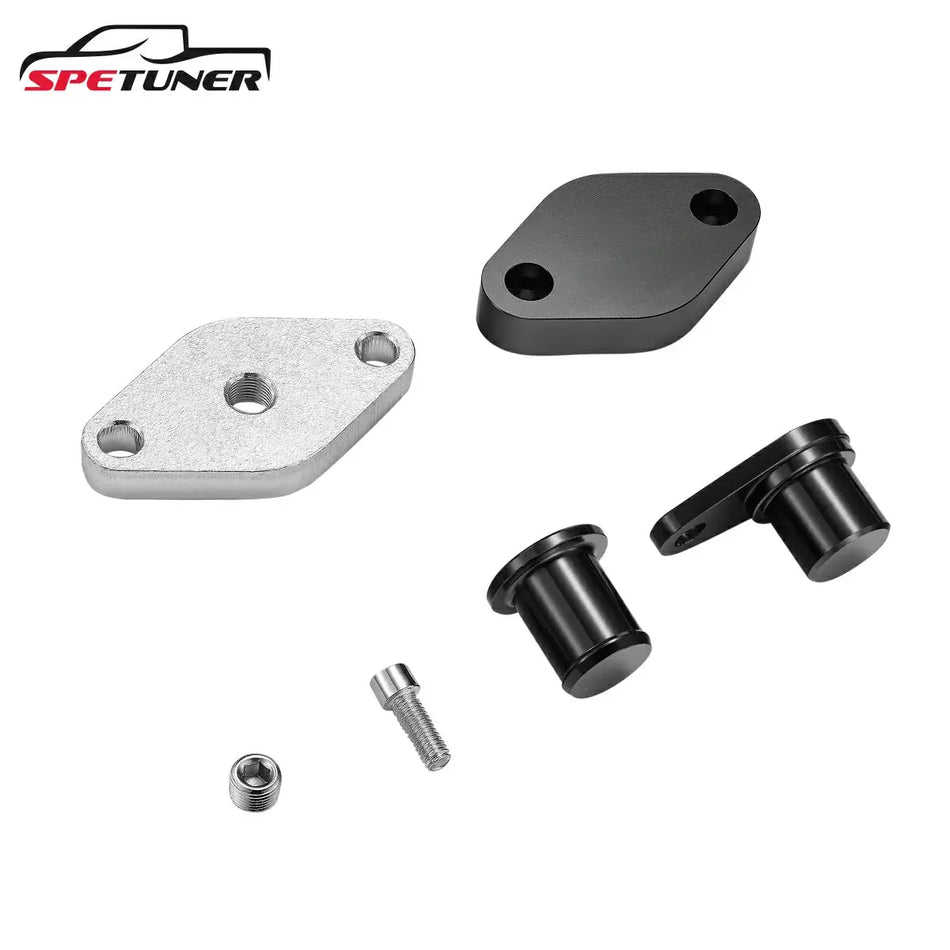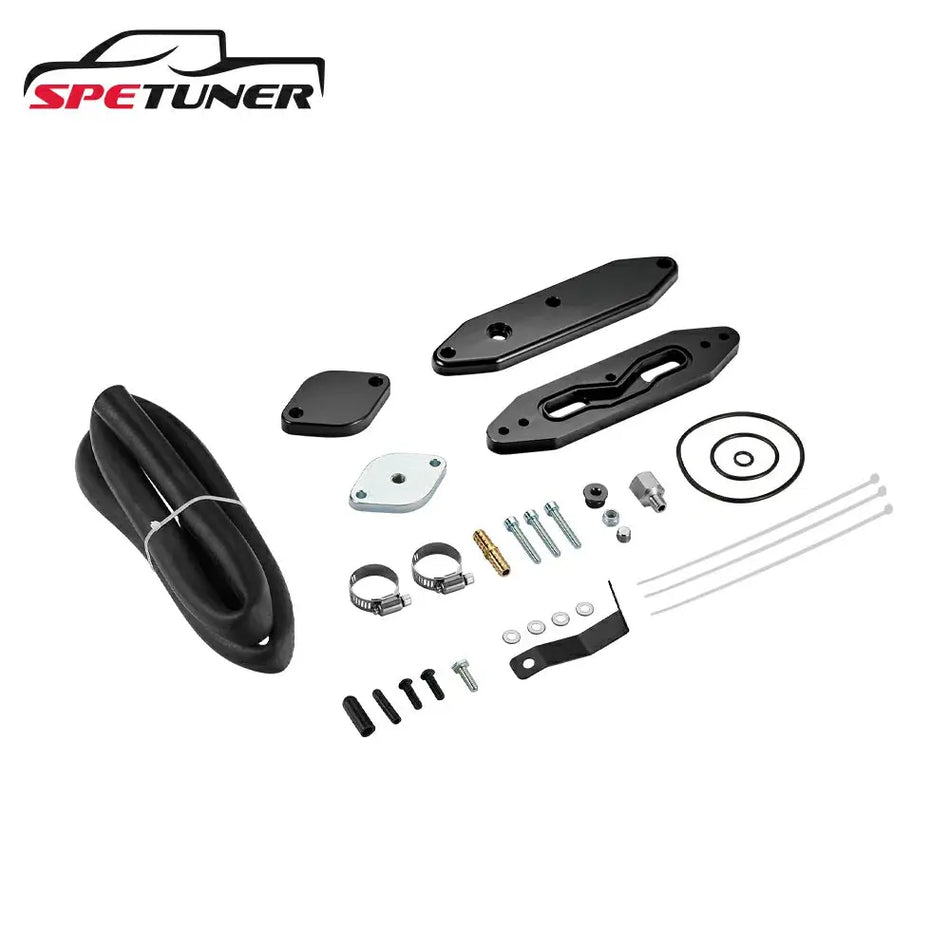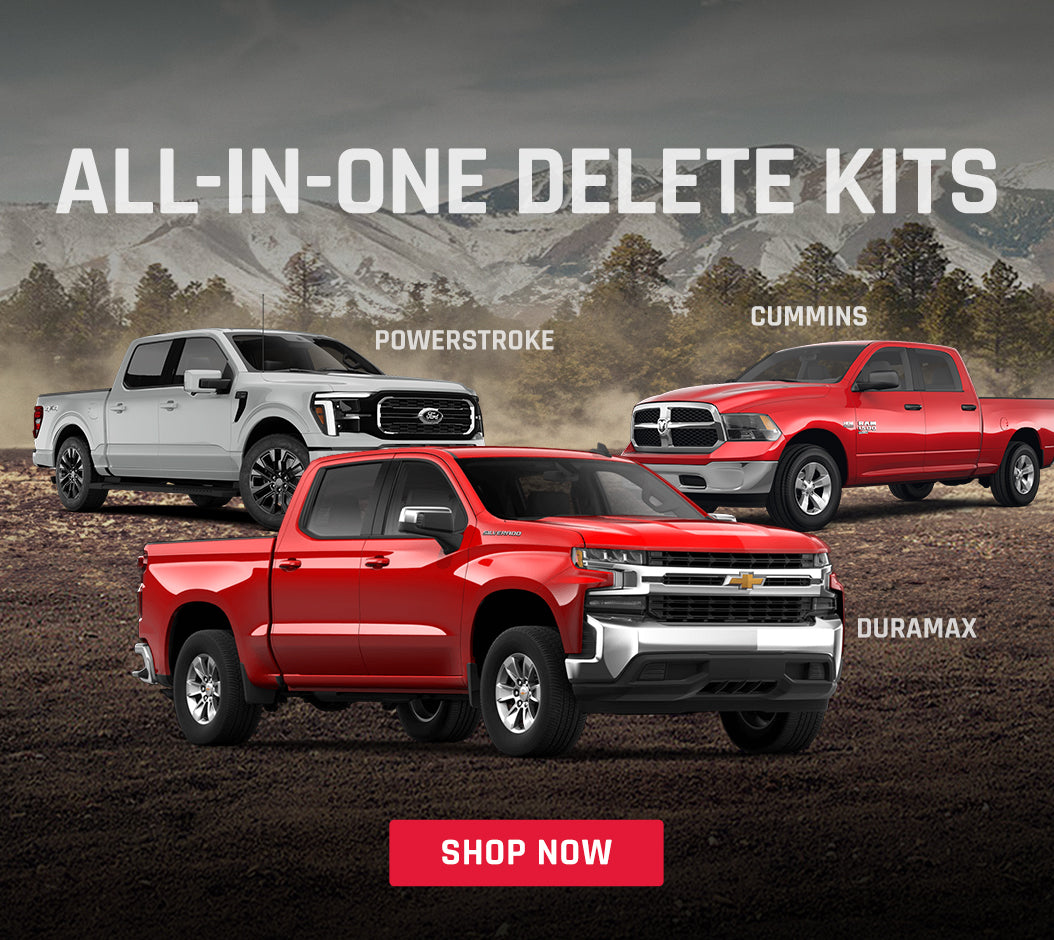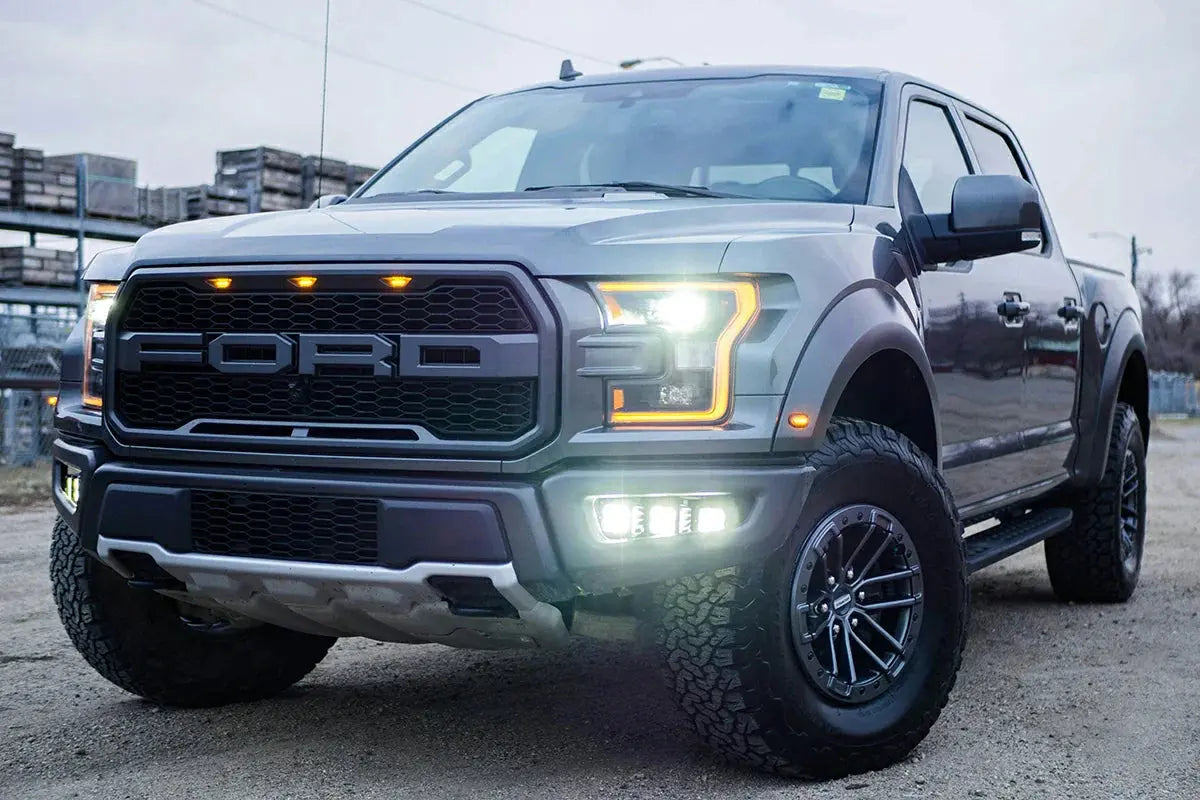Learn how to tell when it’s time to service or replace your stock EGR components or EGR delete solutions on Powerstroke, Cummins, and Duramax diesel engines. Spot early warning signs, protect your engine from costly damage, and keep fuel efficiency consistent with a clear, maintenance-first approach.
Important: The information in this guide applies only to off-road and competition-use vehicles. Always check and follow local emissions regulations before modifying or removing any emissions-control equipment.
The Problem with Stock EGR Systems
- The EGR (Exhaust Gas Recirculation) system is designed to reduce NOx emissions by recirculating a portion of exhaust gas back into the intake. While that helps lower combustion temperatures, it also sends hot, sooty gases through delicate components.
-
Common issues with stock EGR systems include:
- Carbon buildup: Gradual soot accumulation can clog valves, coolers, and intake runners, reducing airflow and response.
- Cooler leaks: Internal cooler failures allow coolant into the exhaust path, leading to coolant loss, white smoke, and potential overheating.
- Performance loss: Over time, plugged passages and sticky valves translate into sluggish throttle response and reduced fuel economy.
- Environmental and compliance risk: A malfunctioning or partially clogged EGR system can cause higher real-world emissions and trigger check-engine lights or inspection failures.
- Key insight: For trucks that tow, idle for long periods, or run in stop-and-go work, EGR-related issues are not a question of “if” but “when.” Proactive planning is essential.

The Solution: EGR Delete Kits (Where Legal)
-
What is an EGR delete kit?
- An EGR delete kit replaces or bypasses the stock EGR hardware on off-road/competition vehicles, removing the components that typically collect carbon and fail.
- By rerouting hot exhaust gases away from the intake tract, the engine can operate with cleaner, cooler incoming air.
-
Advantages of using SPETUNER EGR delete kits (off-road only):
- Performance consistency: Cleaner intake paths help maintain throttle response and boost control over time.
- Fuel efficiency: A stable, soot-free airflow path can help reduce wasted fuel and improve real-world MPG compared with a heavily clogged EGR/intake system.
- Long-term reliability: Eliminating hot, wet exhaust flow through the cooler and intake helps protect the intake manifold, turbocharger, and related sensors from contamination.
- Compliance note: EGR delete modifications are often not legal on vehicles used on public roads. Always verify local emissions rules before making any changes.
-
Product overview (typical ranges):
- Powerstroke EGR solutions: often in the $150–$500 range, depending on platform and included hardware.
- Cummins EGR solutions: typically around $97–$400 for most 5.9L and 6.7L applications.
- Duramax EGR solutions: usually in the $80–$300 range, depending on configuration.
- SPETUNER packages are engineered for platform-specific fitment, with proven materials and hardware to support repeatable, clean installations.
When to Replace Your EGR Delete Components
-
Why replacement or refresh is sometimes necessary:
- The plates and manifolds themselves are generally long-life components, but the system still lives in a hot, high-vibration environment.
- Gaskets, seals, clamps, and hoses can age, harden, or loosen over time, especially on work trucks that see frequent heat cycles and heavy loads.
- Routine inspections help you catch leaks early, avoid boost loss, and maintain the reliability gains you installed the kit for in the first place.
-
Recommended service intervals:
- Annual inspection (minimum): As a baseline, plan to inspect your EGR delete hardware once every 12 months or roughly every 10,000–15,000 miles of hard use.
-
When to refresh components:
- Any sign of soot or coolant at gasket joints, flanges, or plugs.
- Noticeable drop in boost response, new whistling/air-leak noises, or unexplained fuel-economy changes.
- Visible hardening, cracking, or flattening of gaskets, O-rings, or silicone couplers.
- Hardware that has loosened after repeated heat cycles and needs retorquing or replacement.
- Driving conditions matter: Trucks used for towing, hot-climate work, frequent idling, or off-road/competition events should be checked more often and may justify a yearly refresh of wear items.
Specific Recommendations for Major Diesel Engines
Different platforms place different stresses on EGR and delete hardware. Use the table below as a conservative, maintenance-first guideline for annual inspection and service planning.
| Engine Brand | Model Years | Recommended Check | Notes |
|---|---|---|---|
| Powerstroke | 2020–2024 (6.7L) | Annual inspection | Built for sustained towing; check clamps, block-off plates, and coolant reroute components yearly to keep efficiency consistent. |
| 2011–2019 (6.7L) | Annual inspection | Higher system complexity and heat load; expect more frequent gasket and hose refreshes on hard-worked trucks. | |
| 2008–2010 (6.4L) | Annual inspection | Platform is known for cooler-related issues; closely monitor for coolant traces and check fastener torque regularly. | |
| Cummins | 2019–2024 (6.7L) | Annual inspection | Robust design, but high cylinder pressures mean hardware still sees serious stress—inspect block-off surfaces and clamps every season. |
| 2007.5–2018 (6.7L) | Annual inspection | Common workhorse in towing fleets; plan for periodic gasket and hose replacement to prevent small leaks from becoming bigger problems. | |
| 2004.5–2007 (5.9L) | Annual inspection | Mechanically simpler, but age and mileage make proactive hardware checks especially important. | |
| Duramax | 2020–2024 (6.6L L5P) | Annual inspection | Advanced architecture; inspect plates, coolant reroute, and all fasteners annually, especially on tuned or heavily loaded trucks. |
| 2011–2019 (6.6L LML) | Annual inspection | More sensitive to airflow and soot; keep all joints sealed to protect the turbo and aftertreatment system on off-road builds. | |
| 2007.5–2010 (6.6L LMM) | Annual inspection | High-mileage examples are common; hardware fatigue and aged gaskets are the main reasons to refresh components. |
If you run a 2017–2024 L5P Duramax, it’s worth reviewing our in-depth L5P reliability guide to better understand common weak points, supporting modifications, and long-term upgrade planning.

Maximizing Value: Economic Benefits of Regular Service
-
Cost-avoidance perspective:
- Prevent major repairs: A small leak at a blocked EGR port, cooler reroute, or intake joint can snowball into intake-manifold damage, turbo issues, or overheating—repairs that often run into the $1,000–$3,000 range.
- Protect fuel efficiency: Keeping the intake system sealed and soot-free helps maintain consistent combustion, which, over the course of a year of heavy use, can translate into substantial fuel savings.
- Extend engine life: Avoiding coolant contamination, boost leaks, and excessive soot reduces stress on pistons, rings, and bearings and helps the engine stay in its “happy zone” longer.
-
Real-world example:
- Fleet operators that build annual inspections into their maintenance calendar often report fewer unplanned shop visits and more predictable operating costs, compared with trucks that only get attention when something fails.
Why Choose SPETUNER for EGR Delete Solutions?
- Materials and engineering: Components are designed around real-world diesel use, with gasket and hardware choices aimed at long-term sealing under high heat and vibration.
- Installer-friendly design: Clear layouts, labeled components, and documented routing help DIY owners and shops complete clean, repeatable installs.
- Platform-specific coverage: Dedicated options for Powerstroke, Cummins, and Duramax engines mean you’re not trying to adapt generic parts to a critical system.
- Support mindset: Pre-sale fitment help and post-sale guidance are available so you can plan your build, install confidently, and maintain it correctly over the long term.
- Off-road focus: SPETUNER solutions are developed with off-road and competition use in mind, with a clear emphasis on reliability and responsible application.
Step-by-Step Maintenance Recommendations
-
For owners running the stock EGR system (off-road/closed-course use):
- Monitor for classic symptoms: coolant loss, white smoke, sticky EGR valves, or intake clogging.
- Follow the manufacturer’s recommended service intervals and address any EGR-related trouble codes promptly.
- If you’re considering an EGR delete for off-road use, research your platform thoroughly and confirm local regulations before making changes.
-
For owners already using an EGR delete kit (off-road/competition-use only):
- Perform a visual inspection at least once per year—or after intense use—checking all plates, plugs, gaskets, clamps, hoses, and coolant reroutes.
- Retorque hardware after the first few heat cycles and at regular intervals to prevent loosening from vibration.
- Replace any suspect wear items (gaskets, O-rings, clamps, silicone boots) immediately rather than waiting for a leak to worsen.
- Keep records of what was installed and when it was serviced so future diagnostics and upgrades are easier.
Conclusion: The Long-Term Benefits of Annual Replacement
- Stock EGR systems can become a significant reliability risk on hard-working diesel trucks, which is why many off-road builds move toward EGR delete solutions where legal.
- However, even after the stock hardware is removed, your delete components live in a harsh environment and deserve the same inspection discipline as the rest of your engine.
- Routine checks, timely gasket refreshes, and a maintenance-first mindset help you avoid surprise failures, protect fuel economy, and support long engine life.
- Next step: Review the recommended inspection interval for your platform and schedule your next under-hood check so small issues don’t turn into expensive downtime.
FAQs
-
How often should I inspect an EGR delete kit?
For most off-road trucks, a thorough visual inspection once a year—or every 10,000–15,000 miles of hard use—is a smart baseline. High-heat and competition builds may need more frequent checks. -
Do I need to replace the entire EGR delete kit every year?
In most cases, no. The main focus is on monitoring and refreshing wear items such as gaskets, clamps, hoses, and seals. Replace the full assembly only if you see damage, warping, or other clear problems. -
Can regular EGR delete maintenance improve fuel efficiency?
Yes. Keeping all joints sealed and the intake path clean helps maintain proper boost and airflow, which supports stable combustion and can help reduce wasted fuel over time. -
Are SPETUNER solutions legal for road use?
Laws vary widely by country, state, and even municipality. EGR delete modifications are often not legal on emission-controlled vehicles used on public roads. Always check local regulations and use SPETUNER products only in the applications they are intended for (off-road and competition where permitted). -
What are the main benefits of SPETUNER hardware?
Platform-specific fitment, durable materials, and installer-friendly design—backed by knowledgeable support—make it easier to plan, install, and maintain your off-road build with confidence.










